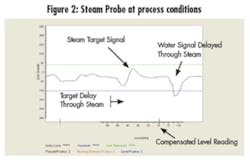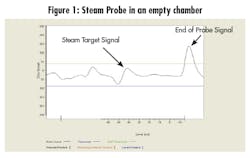Ensuring Level Measurement Accuracy in Saturated Steam Applications
A main advantage of Guided Wave Radar (GWR) over other level measurement technologies is the fact that it is immune to a variety of process conditions. Specific gravity changes, dielectric constant changes, temperature, pressure and vapor space changes all have virtually no effect on the performance of GWR transmitters.
However, one application in which a process variation does affect the performance of GWR can be found in the power industry, where the need for accurate level measurement of boilers, feedwater heaters, and deaerators is important. These applications all contain saturated steam in the vapor space and require special attention.
How Measurement Errors Occur in Saturated Steam Applications
Measurement error can be introduced into a saturated steam system due to speed of propagation variations in the GWR signal relating to vapor space dielectric. However, the error is predictable with the high frequency, electromagnetic pulses travelling down the probe at very near the speed of light.
If the pulses travel in a vapor space with a dielectric constant at or close to 1.00, no significant variation in the speed of propagation is expected. This is a considerable factor for applications where saturated steam exists in the vapor space, because as the temperature (and pressure) of a saturated steam application increases, the dielectric constant of the gas (steam) vapor also increases. This increase in vapor space dielectric causes a delay in the GWR signal propagation as it travels down the probe to the process medium, which results in a measured liquid level appearing lower than actual.
The change in the saturated steam vapor dielectric depends on temperature, and the measurement error associated with the resulting propagation delay can be significant.
Achieving Accurate Level Control with GWR
The Eclipse® Model 706 GWR transmitter and Model 7yS Coaxial Steam probe combine to provide a unique solution to this application. Because the propagation delay is predictable, the effects of the changing steam conditions can be monitored. By knowing the vapor space dielectric, accurate active (continuous) compensation of the actual liquid level reading can be accomplished.
The effects of the changing steam conditions can be compensated for by using a mechanical target placed on the probe within the vapor space. This mechanical target is specially designed to produce an intentional, small signal reflection at a precise, known location.
Magnetrol places the mechanical steam target 5 inches (12.5 cm) down inside of the Model 7yS coaxial probe. Knowing exactly where the target is located at room temperature, and then continuously monitoring its apparent location as the saturated steam conditions change, enables calculation of the vapor space dielectric. In knowing the vapor space dielectric at any given time, accurate compensation of the delayed signal reflection is incorporated and an accurate liquid level reading is accomplished.
Figure 1 is an example of the waveform as displayed using the ECLIPSE DTM and PACTware. A typical steam target signal is shown at room temperature with the probe dry.
Figure 2 shows the same steam probe at process conditions with level on the probe. The signal from the steam target now appears farther out in time.
RELATED: The benefits of Contact Ultrasonic Switches over Tuning Forks
RELATED: Acoustic Volume Mapping for the Measurement of Bulk Solids and Powders in Vessels
This post originally appeared on Magnetrol International’s blog, which can be found at levelandflowsolutions.magnetrol.com/blog/.


